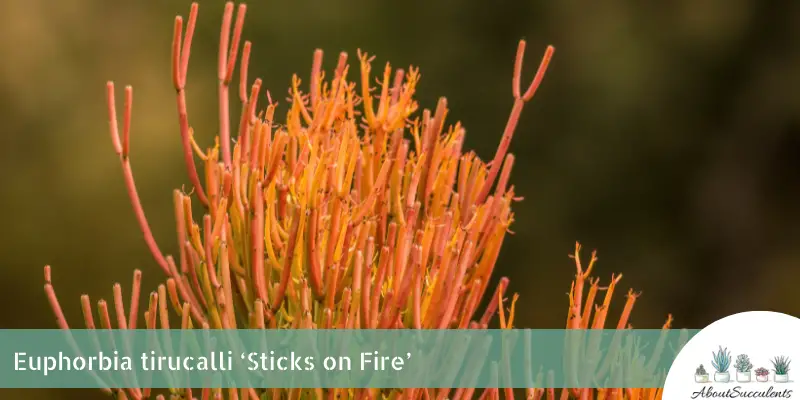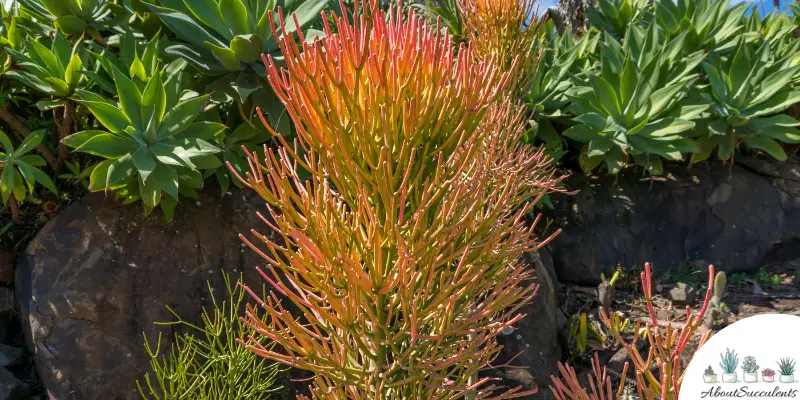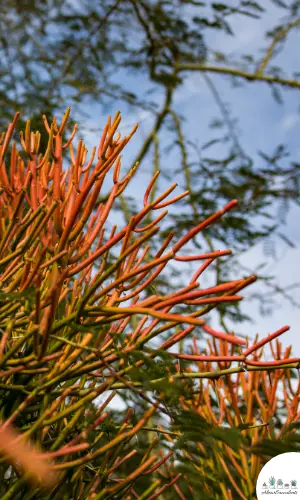
Euphorbia tirucalli is a striking succulent that grows stems in a range of colors notably bright red, yellow, orange, or pink. It’s best grown in containers and used as a captivating accent to any succulent arrangement in your garden.
You can grow Euphorbia tirucalli as a houseplant but keep in mind why this beautiful succulent goes by the aliases, “Sticks on Fire”, “Fire Stick Plant”, and “Petroleum Plant”.
Sticks on Fire is highly toxic. This is a type of succulent that contains a milky sap that can irritate your skin.
Once in contact, your skin might develop redness and you might feel a burning sensation. If the sap gets into your eyes, irritation and even temporary blindness might occur.
As a houseplant, keep Petroleum Plant in a location that’s inaccessible to your pets. If your dog or cat accidentally ingests a part of the plant, it can burn the lips, mouth, and tongue.
Despite the toxicity, people still grow Euphorbia tirucalli for its splendid appearance that adds a sense of elegance to any garden or home interior.
The stems have a cylindrical shape; fleshy, smooth, that grow in whorls. Euphorbia tirucalli is considered a small tree as it can range in height from 2.5m (8”) to 5m (16”).
The leaves are droopy and measure 2.5cm (1”). In the wintertime, you might be greeted with small, yellow flowers that appear at the apex of its branches.
Sticks on Fire is native to Africa and is a member of the Euphorbiaceae family.
General Information:
Also known as: Sticks on Fire, Fire Stick Plant, and Petroleum Plant.
Plant Family: Euphorbiaceae
Origin: Africa
Height: 2.5m (8’)
Exposure: Full or partial sun for up to 6 hours.
Water Needs: Cannot tolerate long periods of drought; you might have to water once every 7 to 10 days during summer but make sure the soil is 100% dry.
Soil Type: Sandy, well-draining soil; 2:1 ratio of Cactus soil mix and perlite for better drainage.
Soil pH: 5.5 to 6.5
How to Grow and Care for Euphorbia Tirucalli “Sticks on Fire”

When handling Euphorbia tirucalli, it’s strongly recommended to wear gardening gloves and goggles. Other than the safety measures, you won’t have a hard time growing and caring for Euphorbia tirucalli.
Sunlight
Sticks on Fire will grow to their maximum radiant beauty when regularly exposed to full sunlight. As part of your outdoor garden, place Fire Stick Plant in an area that gets 6 hours of direct morning sunlight every day.
If your garden gets mostly partial sunlight, grow Euphorbia tirucalli in a pot that you can move to areas that get full sun. Partial sunlight is fine but to get the most out of Sticks on Fire, give it some exposure to the full rays of the morning sun.
The same rule follows if you decide to grow Euphorbia tirucalli as an indoor plant – it will require direct sunlight. You have to place the plant in a location that gets bright sunlight 5 to 6 hours per day.
In cold regions, where the temperatures drop below -1.1° C (30° F), grow Sticks on Fire in a pot that can be moved indoors. This is a variety of succulent plant that isn’t cold-hardy and will not thrive in very cold temperatures.
Buy a Grow Light to give Euphorbia tirucalli the light it needs to grow indoors during the winter months.
Watering

Euphorbia tirucalli is well-adapted to dry climates but doesn’t handle long periods of drought very well.
In the summertime, you might have to water at least once every 7 to 10 days. The important thing to keep in mind is to give water only when the soil is completely dry. Overwatering will lead to root rot which develops into a fungal infection.
This means that Sticks on Fire will need less water in the wintertime because the soil will stay moist longer.
The best way to find out if the soil is ready for watering is to insert a stick one inch into the soil. If the stick comes out dry, then the soil is ready for water.
To be more certain, use tools that measure the moisture level of the soil such as a Hygrometer or a moisture meter.
Always water the soil and not the plant. If you water overhead and get the plant drenched, it will remain moist for a longer period of time. Water the soil and give it a good soaking.
Pot and Soil
A pot made of ceramic material or terracotta is your best choice for Euphorbia tirucalli because it allows moisture to escape freely from the soil. The pot must also have a drain hole with a mesh net at the bottom for excess water to pass through.
Fire Stick Plant grows best in sandy or well-draining soil. A good combination is a 2:1 ratio of Cactus mix to perlite.
How to Propagate Euphorbia Tirucalli – Sticks on Fire
Euphorbia tirucalli is easy to propagate with the use of its stems. Keep in mind that you’ll be cutting the stem. Always wear gloves and goggles when propagating the succulent to keep the milky sap from coming in contact with your skin, eyes, and mouth.
Method 1: Cuttings
Step 1: Choose a healthy stem from the plant and cut it with a sterilized and sharpened pair of garden shears.
Step 2: Place the stem cuttings in a warm and dry area and let it develop hard calluses over a period of 2 to 3 days.
Step 3: Plant the stem cutting on sandy, well-draining soil. Lightly mist the soil over the next few days.
Step 4: If the stems have taken root, water the soil only when it’s stone dry.
Frequently Asked Questions
Is Euphorbia Tirucalli “Sticks on Fire” Toxic to Cats and Dogs?
Although Euphorbia Tirucalli is not included in the list of plants that are toxic to animals in the website of the American Society for the Prevention of Cruelty to Animals (ASPCA), this is a type of succulent that is highly toxic to cats and dogs.
Why Is My Euphorbia Tirucalli “Sticks on Fire” Dying?
Your Euphorbia tirucalli might be dying because of 3 possible factors: Overwatering, Underwatering, and Pest
Infestation.
Overwatering
When the roots are kept in a moist environment for a long time, the cells can expand to a point where they burst. The roots will start to rot and infection will follow soon after.
There are 2 signs of overwatering to look out for:
– Discoloration of the leaves
– Leaves appear mushy and soft
The first thing you have to do is to cut back on the watering schedule. Second, get a pair of sterilized garden scissors and cut off the parts of the plant that have discoloration.
Next, remove the plant from its soil and cut out all of the roots that have rotted away. Finally, refill a new pot with sandy, well-draining soil and replant Sticks on Fire.
Underwatering
If the leaves of Euphorbia tirucalli look shriveled up, this means it lacks water. Fire Stick Plant is a resilient succulent but it needs to receive water when the soil has dried out.
Water is crucial for all types of plants to absorb the nutrients from the soil. While it’s better to under-water Sticks on Fire, giving it too little will also do more harm than good.
Pest Infestation
Toxic sap notwithstanding, pests such as mealybugs and aphids will find their way into your succulent plant.
These pests can drain the sap or leave waste products that can do harm to Sticks on Fire. If you see white, cotton-like substances growing on Euphorbia tirucalli’s leaves, wipe them off with a cotton ball that’s soaked in 70% isopropyl alcohol.
You can also spray Fire Stick Plant with neem oil to keep the pests away. In your outdoor garden, you can unleash ladybugs which are natural enemies of these pests.
Does Euphorbia Tirucalli “Sticks on Fire” Produce Flowers?
Yes, Euphorbia Tirucalli produces small, yellow flowers that grow in clusters during the wintertime.
Last Updated on June 9, 2022 by Sofia Lara